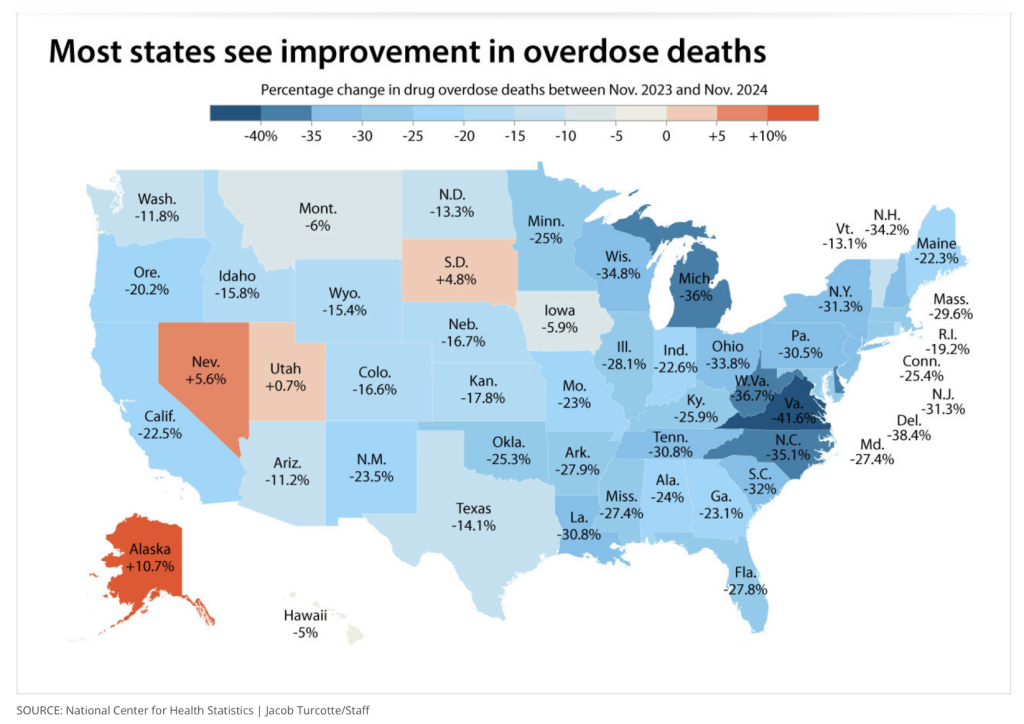MEDIA CONSULT EXPERTS TO CELEBRATE NEW CDC DATA POINTING TO A WORSENING OPIOID CRISIS
Media reporting eschews doubt, analyses, thought, instead lists expert distractions required to mystify recent drops in fatal opioid overdoses – mystify to hide a trend reflecting a worsening crisis
by Clark Miller
Published June 6, 2025
The news is dramatic and dramatized, remarkable, and a remarkable victory over the crisis that has taken increasing numbers of lives over past decades, with almost no letup.
In 2024, an astounding 27 percent drop in opioid overdose deaths nationwide, with wide variation among states.
Generating celebratory headlines like,
and,
What a great headline, right? Just an unchecked impulse away from,
What opioid crisis? 46 states recorded a decline in overdose deaths.
That actually would have captured it even better, more assuredly and triumphantly.
Captured the desperate need to convey some good news, news of the competence and value of scientific and medical institutions, news desperately required to protect the status and privilege of America’s expert class in the wake of generation of the avoidable crisis, of exposure of a populace to the predictable failure and harms of SSRIs for depression, of the culpability and lies and harms of medical institution response to the COVID pandemic, harms and lies yet to play out over generations.
There’s just … a problem.
A big one, actually, ands it begins with the established fact that trends in opioid overdose deaths do NOT measure the severity, course, or progress against the lethal epidemic.
That’s covered here and here, and here. It should be obvious. It’s because since the beginning of the opioid epidemic, differences temporally and among comparison groups have been intractably confounded by the effects of differential provision and use of naloxone on prevalence of fatal opioid overdoses.
Narcan saves invalidate opioid OD death trends
as a valid measure of severity of the crisis because, clearly, Narcan does not reduce high-risk use, does not treat the condition of compulsive use of opioids, instead is desperately, increasingly required due to high-risk use, a valid measure of treatment success or failure.
There are measures that do have validity, including incidence of opioid injection related infectious disease, a direct measure of high-risk use = gold standard treatment failure.
And nonfatal opioid overdoses, not confounded, like fatal ODs, by differential, uncontrolled (experimentally) emergency naloxone saves potentially falsely attributing decreased deaths to treatments (= gains against the epidemic), nonfatal ODs thereby a valid measure of severity.
Used to be, that is, a valid measure, no longer as established by a large body of consistent outcomes establishing that the very key to success of targeted, community naloxone campaigns that are entirely responsible for drops in fatal overdoses are the largely unreported (or in any case never entered in medical or other data bases mined for research) OD reversals increasingly happening in homes, on the streets, and in community settings, typically without incentive or with disincentive for those involved to have emergency responder or medical contact (described, for example here).
That’s just … a problem, a really big one, ensuring that all the recent analyses, confident conclusions, and media triumphant messaging of gains against the epidemic are lethal lies, while evidence points clearly to persistently increasing high-risk opioid use, requiring desperate naloxone campaigns to avert fatal ODs = gold standard treatment failure.
And all those factors conveyed by experts to useful journalists to ensure protective uncertainty as to just what is causing the drops in fatal ODs?
That’s a big problem too, none of those supported by evidence, logic, or expectations that they are not starkly inconsistent with basic facts, explained here and here.
Meanwhile, it’s the extreme variability among U.S. states and locales and along timelines that provide the exceptions that prove the lethal rule, that establish the consistent pattern of persistently increasing high-risk opioid use, fueled by expert gold-standard treatments, moderated only and not without intensive, targeted, community based naloxone campaigns, as harm reduction against expert treatment failure.
Three of those revelatory exceptions are Nevada, Utah, and South Dakota, united in delay and ineffectiveness of naloxone campaigns that in other states and locales have been dramatically successful, accounting entirely for the drops.
Those exceptions stick out prominently, unable to be hidden or mystified.
They tell us what we need to know about expert gold standard treatments and deaths.









